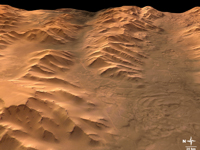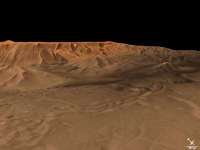Navigation/Menü: Links auf weitere Seiten dieser Website und Banner
03.11.2004
HRSC Bildserie #121 - Tithonium Chasma (Orbit 0442)
HRSC Press Release #121 - Tithonium Chasma (orbit 0442)
 Am 26. Mai 2004 nahm die hochauflösende Stereokamera (HRSC) auf der ESA Sonde
Mars Express im Orbit 442 das Gebiet der westlichen Valles Marineris mit einer
Auflösung von 52 Metern pro Bildpunkt auf. Die Abbildungen zeigen den Anfang des
Canyonsystems bei 7° südlicher Breite und 269° östlicher Länge.
Am 26. Mai 2004 nahm die hochauflösende Stereokamera (HRSC) auf der ESA Sonde
Mars Express im Orbit 442 das Gebiet der westlichen Valles Marineris mit einer
Auflösung von 52 Metern pro Bildpunkt auf. Die Abbildungen zeigen den Anfang des
Canyonsystems bei 7° südlicher Breite und 269° östlicher Länge.
On 26 May 2004 the High-Resolution Stereo Camera (HRSC) onboard the ESA spacecraft Mars Express obtained image data of the western end of the Valles Marineris Canyon system. The image data were taken in orbit 442 with a ground resolution of approximately 52 metres per pixel. The displayed region is located at the beginning of the canyon system at about 7° southern latitude and 269° eastern longitude.
 Das aufgenommene Gebiet zeigt den Anfang der Täler Tithonium Chasma und Ius
Chasma, beides Teilbereiche des Valles Marineris, die hier bis zu 5,5 Kilometer
tief sind. Die Canyons von Valles Marineris sind durch eine Vielzahl
geologischer Prozesse entstanden, vermutlich spielten dabei tektonische
Prozesse, Wasser und Wind, Vulkanismus sowie glaziale Aktivität wichtige Rollen.
Der Boden der Canyons wird von dunklen geschichteten Gesteinen, den so genannten
Interior Layered Deposits, bedeckt. Diese Gesteine sind von polygonalen Brüchen
durchzogen, an denen deutlich helleres Material zu Tage tritt. Der Ursprung
dieser geschichteten Gesteine ist bisher nicht eindeutig geklärt, zum Teil sind
sie vermutlich vulkanischen Ursprungs, in einigen Gebieten ist jedoch auch eine
sedimentäre Herkunft möglich.
Das aufgenommene Gebiet zeigt den Anfang der Täler Tithonium Chasma und Ius
Chasma, beides Teilbereiche des Valles Marineris, die hier bis zu 5,5 Kilometer
tief sind. Die Canyons von Valles Marineris sind durch eine Vielzahl
geologischer Prozesse entstanden, vermutlich spielten dabei tektonische
Prozesse, Wasser und Wind, Vulkanismus sowie glaziale Aktivität wichtige Rollen.
Der Boden der Canyons wird von dunklen geschichteten Gesteinen, den so genannten
Interior Layered Deposits, bedeckt. Diese Gesteine sind von polygonalen Brüchen
durchzogen, an denen deutlich helleres Material zu Tage tritt. Der Ursprung
dieser geschichteten Gesteine ist bisher nicht eindeutig geklärt, zum Teil sind
sie vermutlich vulkanischen Ursprungs, in einigen Gebieten ist jedoch auch eine
sedimentäre Herkunft möglich.
Der große, stark erodierte Krater Oudemans im Süden hat einen Durchmesser von
ungefähr 120 km. Um seinen Zentralberg lässt sich eine weitflächige Ebene aus
dunklen Gesteinen erkennen, die von (durch Wind eingetragene) Ablagerungen zum
Teil bedeckt werden. In der Bildszene sind mehrere Brüche in der Marskruste zu
erkennen, die in verschiedenen Richtungen verlaufen. Eines ist das System, das
durch die Valles Marineris selbst gekennzeichnet ist und in Ost-West Richtung
verläuft. Im Süden des großen Kraters verläuft ein Störungssystem von schmalen
Gräben in nordwestlich-südöstlicher Richtung, nördlich sind weitere, zum Teil
nur schwach ausgeprägte Systeme zu erkennen.
Valles Marineris ist eines der bestuntersuchten Gebiete auf dem Mars, da die
Canyonsysteme zahlreiche Schlüssel für die vulkanische und tektonische
Geschichte enthalten. Die Sedimente auf den Talböden und die Erosionsstrukturen
lassen zudem ein genaueres Bild der klimatischen Geschichte des Mars zeichnen.
Die neuen Aufnahmen der HRSC bieten durch die Stereofähigkeit der Kamera neue
Möglichkeiten, Zusammenhänge und Lagerungsverhältnisse zu erkennen und die
geologische Geschichte des Mars mit neuer Genauigkeit zu rekonstruieren.
 The image scene shows the western end of the canyons Tithonium Chasma and Ius
Chasma, part of the Valles Marineris canyon system, with depths of 5.5
kilometers. The canyon system is the result of a variety of geologic processes,
probably, tectonic rifting, by water and wind, volcanism and glacial activity
played a major role in its formation and evolution. The canyon floors are
covered by a dark, layered material, the so called Interior Layered Deposits.
These deposits are marked by a system of polygonal cracks through which the
underlying, lighter-coloured rock can be seen. The Interior Layered Deposits are
still a major topic in research. Parts of the deposits are most probably
volcanic, in other areas, a sedimentary origin has been proposed. The morphology
of the valley flanks has been modified by slumping and rockfall. Some of the
major slumps are more than thirty kilometers wide. The flanks are often covered
to a large extent by their own talus. These deposits are a sign of the long
erosional history of this area.
The image scene shows the western end of the canyons Tithonium Chasma and Ius
Chasma, part of the Valles Marineris canyon system, with depths of 5.5
kilometers. The canyon system is the result of a variety of geologic processes,
probably, tectonic rifting, by water and wind, volcanism and glacial activity
played a major role in its formation and evolution. The canyon floors are
covered by a dark, layered material, the so called Interior Layered Deposits.
These deposits are marked by a system of polygonal cracks through which the
underlying, lighter-coloured rock can be seen. The Interior Layered Deposits are
still a major topic in research. Parts of the deposits are most probably
volcanic, in other areas, a sedimentary origin has been proposed. The morphology
of the valley flanks has been modified by slumping and rockfall. Some of the
major slumps are more than thirty kilometers wide. The flanks are often covered
to a large extent by their own talus. These deposits are a sign of the long
erosional history of this area.
The large, deeply eroded crater Oudemans in the south of the image area has a
diameter of about 120 kilometers. Around the central mount of the crater, large
plains composed of dark rock can be seen. These plains are covered by lighter
sediments, implaced by the action of wind.. Several systems of tectonic faults
can be distinguished in the imaged area. The most prominent is the east-west
trending system of Valles Marineris itself. South of Oudemans crater, smaller
tectonic grabens running from the southwest to the northeast can bee seen. To
the north of the large canyons, further fault systems can be identified.
The Valles Marineris region is one of the best-researched areas on Mars. The
canyon system is one of the major keys to the tectonic and volcanic history of
Mars. Research on the sedimentary rocks and the products of erosion can provide
major insights into the climatic evolution. Due to the stereo capability of the
Camera, the new image data gained by the HRSC provide new insights into the
geology of mars. This will lead to a new, more precise reconstruction of the
martian geologic history.
 Die Farbansichten wurden aus dem senkrecht blickenden Nadirkanal und den Farbkanälen erstellt, die Schrägansicht wurde aus den Stereokanälen der HRSC berechnet. Die Anaglyphen werden aus dem Nadirkanal und einem Stereokanal abgeleitet. Die schwarzweißen Detailaufnahmen wurden dem Nadirkanal entnommen, der von allen Kanälen die höchste Auflösung zur Verfügung stellt.
Die Farbansichten wurden aus dem senkrecht blickenden Nadirkanal und den Farbkanälen erstellt, die Schrägansicht wurde aus den Stereokanälen der HRSC berechnet. Die Anaglyphen werden aus dem Nadirkanal und einem Stereokanal abgeleitet. Die schwarzweißen Detailaufnahmen wurden dem Nadirkanal entnommen, der von allen Kanälen die höchste Auflösung zur Verfügung stellt.
The colour scenes have been derived from the three HRSC-colour channels and the nadir channel. The perspective views have been calculated from the digital terrain model derived from the stereo channels. The anaglyph image was calculated from the nadir and one stereo channel. The black and white high resolution images were derived form the nadir channel which provides the highest detail of all channels.
 Das Kameraexperiment HRSC auf der Mission Mars Express der
Europäischen Weltraumorganisation ESA wird vom Principal Investigator Prof. Dr.
Gerhard Neukum (Freie Universität Berlin), der auch die technische Konzeption der
hochauflösenden Stereokamera entworfen hatte, geleitet. Das
Wissenschaftsteam besteht aus 40 Co-Investigatoren aus 33 Institutionen und zehn
Nationen. Die Kamera wurde am Deutschen Zentrum für Luft- und Raumfahrt (DLR) unter der
Leitung des Principal Investigators (PI) G. Neukum entwickelt und in Kooperation mit
industriellen Partnern gebaut (EADS Astrium, Lewicki Microelectronic GmbH und Jena
-Optronik GmbH). Sie wird vom DLR -Institut für Planetenforschung in Berlin-Adlershof
betrieben. Die systematische Prozessierung der Daten erfolgt am DLR. Die Darstellungen
wurden vom Institut für Geologische Wissenschaften der FU Berlin in Zusammenarbeit
mit dem DLR-Institut für Planetenforschung erstellt.
Das Kameraexperiment HRSC auf der Mission Mars Express der
Europäischen Weltraumorganisation ESA wird vom Principal Investigator Prof. Dr.
Gerhard Neukum (Freie Universität Berlin), der auch die technische Konzeption der
hochauflösenden Stereokamera entworfen hatte, geleitet. Das
Wissenschaftsteam besteht aus 40 Co-Investigatoren aus 33 Institutionen und zehn
Nationen. Die Kamera wurde am Deutschen Zentrum für Luft- und Raumfahrt (DLR) unter der
Leitung des Principal Investigators (PI) G. Neukum entwickelt und in Kooperation mit
industriellen Partnern gebaut (EADS Astrium, Lewicki Microelectronic GmbH und Jena
-Optronik GmbH). Sie wird vom DLR -Institut für Planetenforschung in Berlin-Adlershof
betrieben. Die systematische Prozessierung der Daten erfolgt am DLR. Die Darstellungen
wurden vom Institut für Geologische Wissenschaften der FU Berlin in Zusammenarbeit
mit dem DLR-Institut für Planetenforschung erstellt.
The High Resolution Stereo Camera (HRSC) experiment on the ESA Mars Express Mission is led by the Principal Investigator (PI) Prof. Dr. Gerhard Neukum who also designed the camera technically. The science team of the experiment consists of 40 Co-Investigators from 33 institutions and 10 nations. The camera was developed at the German Aerospace Center (DLR) under the leadership of the PI G. Neukum and built in cooperation with industrial partners (EADS Astrium, Lewicki Microelectronic GmbH and Jena-Optronik GmbH). The experiment on Mars Express is operated by the DLR Institute of Planetary Research, through ESA/ESOC. The systematic processing of the HRSC image data is carried out at DLR. The scenes shown here were created by the PI-group at the Institute for Geological Sciences of the Freie Universitaet Berlin in cooperation with the German Aerospace Center (DLR), Institute of Planetary Research, Berlin.
© Copyright: ESA/DLR/FU Berlin (G. Neukum)
Download
hochaufgelöste Bilddaten /
full resolution image data
Nadiraufnahme / Grayscale Nadir Image | download TIF (58.7 MB) |
RGB Farbbild / RGB Colour Image | download TIF (176.1 MB) |
Rot-Cyan Anaglyphe / Red-cyan anaglyphe | download TIF (191.9 MB) |
Perspektive #1 / Perspective view | download TIF (111.2 MB) |
Perspektive #2 / Perspective view #2 | download TIF (111.2 MB) |

 English
English

